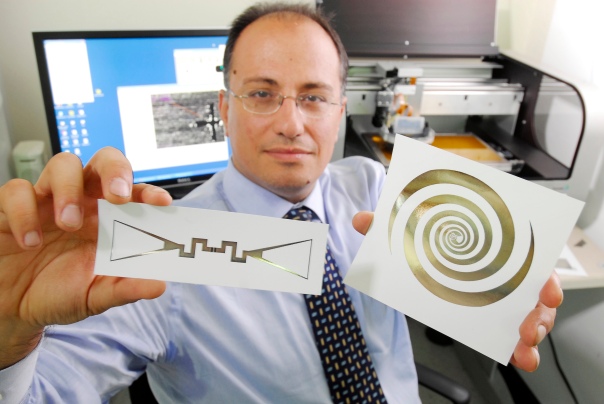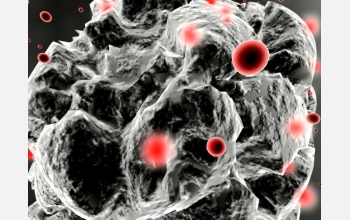The term “terrorism” is becoming quite ubiquitous in our everyday lives. It seems that you can hardly watch a news report, browse the internet, listen to a podcast, or tune into your favorite radio station without being made aware of the most recent terrorist attack that has happened here or abroad. The prevalence of these acts is quite disheartening. However, as a scientist in the field of nanotechnology, I can tell you that there is a bright side, or a silver lining to this particular societal cloud. In essence, “necessity is the mother of invention!” The unfortunate rise in the number of terrorist attacks around the world has resulted in many scientists in the field of nanotechnology devoting effort toward the use of nanoparticles in the fight against terrorism.

The Merriam-Webster dictionary gives the simple definition of terrorism as “the use of violent acts to frighten the people in an area as a way of trying to achieve a political goal” and the full definition as “the systematic use of terror especially as a means of coercion.”1 You can find more detailed definitions used by the Department of State and the Federal Bureau of Investigation (FBI).2 For the sake of clarity, in this post I will refer to the simpler definition, with a specific emphasis on toxic chemicals used as form of warfare agents against innocent targets.
Nanotechnology, and nanoparticles specifically, are likely not the first thing that comes to mind when most people consider the fight against terrorism. However, nanoparticles have some particularly advantageous properties that can be exploited for this very use:
- Nanoparticles are very, very, very small and can have many shapes. The ability to change the size and shape of nanoparticles makes them extremely versatile, which means they can be adapted to address many types of threats associated with terrorism (more details on this later).
- Nanoparticles have a high surface to volume ratio, which means they are very efficient attaching themselves to targets such as toxic chemicals meant to harm innocent people, animals, or crops, etc.
- Nanoparticles can also be made to be porous (filled with holes). Porous nanoparticles can be filled with sensing and neutralization agents that make them excellent at alerting authorities to a terrorist threat, even when the threat is only present at low levels.
- Nanoparticles can be packaged in different forms like solids, gels, and aerosols. This makes them potentially useful in a range of contexts for law enforcement, military, and research scenarios.
- Lastly, many nanoparticle-based technologies that are focused on aiding in the fight against terrorism have the added benefit of easy disposal. For example, some solid nanoparticle-based materials that are designed to neutralize a threat substance can then simply be thrown away without needing any extra steps to make the materials safe. Moreover, in many cases there have been efforts to make all of the byproducts “green” or nontoxic to the environment.
Nanoparticle-based applications are particularly suited for two aspects of the fight against terrorism: rapid detection and neutralization of a terrorist threat. Rapid detection is the ability to accurately detect the presence of a terrorist threat, for example a chemical warfare agent, in a short time span. Neutralization is the ability to transform a toxic agent into a nontoxic form. Here are a few exciting and innovative examples from the last five years that illustrate how scientists all over the world are using the advantageous characteristics of nanoparticles to ensure that nanotechnology plays a key role in the fight against terrorism.
Rapid Detection of Threat
⇒ In 2013, Scientists from the Institute of Biophysics at the Chinese Academy of Sciences developed a system for the rapid detection of a nerve agent, Sarin. The system is based on iron oxide metal nanoparticles. It can sense the presence of the highly toxic nerve agent in a matter of minutes and the results of the test are easily read out via a color change of the test solution.3 This application is particularly cool because it provides a quick read-out that is easily interpreted.

⇒ MIT Scientists have developed protein coated carbon nanotubes for the detection of very small traces of explosives. Carbon nanotubes are very small, cylindrical tubes made out of carbon that have ultrathin walls. In this project, coating carbon nanotubes with various types of proteins from bee venom made them useful for detecting different types of explosives at the single molecule level (much more sensitive than typical methods).4,5
⇒ Scientists from Georgia Tech developed a wireless sensor prototype based on carbon nanotubes that can be used to detect the presence of improvised explosive devices or IEDs. This is extra cool because the carbon nanotubes are printed directly on paper using a common inkjet printing technology This sensor is very promising as it is low cost and can be used anywhere.6

Neutralization of Threat
⇒ FAST-ACT®, which stands for First Applied Sorbent Treatment-Against Chemical Threats, is a product offered by Timilon Technology Acquisitions LLC. The company uses NanoActive® metal oxides “for the destruction of toxic and noxious materials, including air and water pollutants, hazardous chemicals, biological organisms, odors and chemical warfare agents.” Specifically, FAST-ACT is non-flammable, non-corrosive, and can be used to significantly reduce both liquid and vapor hazards.7 It comes in many different forms (liquid, vapor, or on mitts) and can be safely used in a variety of environments. This product has been shown to be highly effective in neutralizing the chemical warfare nerve agents VX, Soman, and mustard gas. It is also very versatile as it can be safely used by the military, first responders, and scientists.8

⇒ Silica nanoparticles filled with special reactive chemicals have been successfully used in the removal of several chemical nerve and blister warfare agents including Sarin. The nanoparticles were able to absorb the toxic chemicals and neutralize them by changing them into nontoxic chemicals in only a few minutes.9 This application is an example of how scientists can take advantage of the porosity of certain kinds of nanoparticles to target them toward specific toxic chemical agents used in terrorist attacks.
⇒ Scientists from the Department of Nanoengineering at the University of California, San Diego developed self-propelled “micro-motors” for use in neutralizing an anthrax threat in natural water. The so called “micro-motors” are made of magnesium microparticles, coated with a titanium oxide shell that has gold nanoparticles embedded in it. As if self-propulsion and anthrax eradication aren’t impressive enough, the environmentally friendly micro-motors convert toxic agents into environmentally safe products, making them an especially “green” solution that can be applied to a chemical or biological warfare agent.10

Nanotechnology is quickly becoming a part of our everyday lives. More specifically, nanoparticles are now included in many consumer products including electronics, cosmetics, and medicine. The fight against terrorism, another familiar topic in many of our lives, has also been influenced by nanotechnology. Nanotechnology can make use of the best qualities of nanoparticles in a variety of ways, especially enabling rapid detection and neutralization of toxic chemical agents in various environments. I’m proud to know that some of the research done on a daily basis in scientific labs across the world is being used to positively impact global society by helping in the fight to keep innocent people safe from certain types of terrorist attacks. GO NANOSCIENCE!!!
EDUCATIONAL RESOURCES
- Want to know more about carbon nanotubes? Check out our posts on plastic bags, flame retardants, water purification, and bicycle tires.
- For more on “micro-motors,” see our posts on their potential for future use in medical applications and oil spill cleanup; another post discusses nano-sensors.
- Introduction to Nanoscience: Teacher Lesson Plan
- Teach Engineering: Thirsty for Gold hands-on activity on nanosensors (grades 7-12)
- Terrorism [Def. 1]. Merriam Webster Online,Retrieved from http://www.merriam-webster.com/dictionary/terrorism
- National Institute of Justice. Terrorism, 2011. Retrieved from http://www.nij.gov/topics/crime/terrorism/pages/welcome.aspx
- Liang, M. et al. Fe3O4 magnetic nanoparticle peroxidase mimetic-based colorimetric assay for the rapid detection of organophosphorus pesticide and nerve agent. Analytical chemistry, 2012, 85(1), pp.308-312. DOI: 1021/ac302781r
- Homeland Security Research. Current ETD Technologies, Retrieved from http://homelandsecurityresearch.com/downloads2/
- Trafton, A. Finding a needle in a haystack, MIT News, Retrieved from http://news.mit.edu/2011/explosive-detection-0510
- Toon, J. Printed Protection: Low-cost Paper-based Wireless Sensor Could Help Detect Explosive Devices. Georgia Tech Research Institute [website, n.d.] Retrieved from http://www.gtri.gatech.edu/casestudy/paper-based-wireless-sensors
- National Science Foundation. Nano-engineered Powders Tackle Toxic Chemicals, Retrieved from http://www.nsf.gov/discoveries/disc_summ.jsp?cntn_id=104102
- Technology, 2016 [website] Retrieved from http://www.timilon.com/technology/
- Saxena, A. et al. Removal of sulphur mustard, sarin and simulants on impregnated silica nanoparticles. Journal of Hazardous Materials, 2012, 211, 226-232. doi: 10.1016/j.jhazmat.2011.07.117
- Li, J et al. Water-driven micromotors for rapid photocatalytic degradation of biological and chemical warfare agents. ACS Nano, 2014, 8(11), 11118-11125. DOI: 1021/nn505029k

[…] original en inglés por Taeyjuana Curry Traducido por Jeremy […]